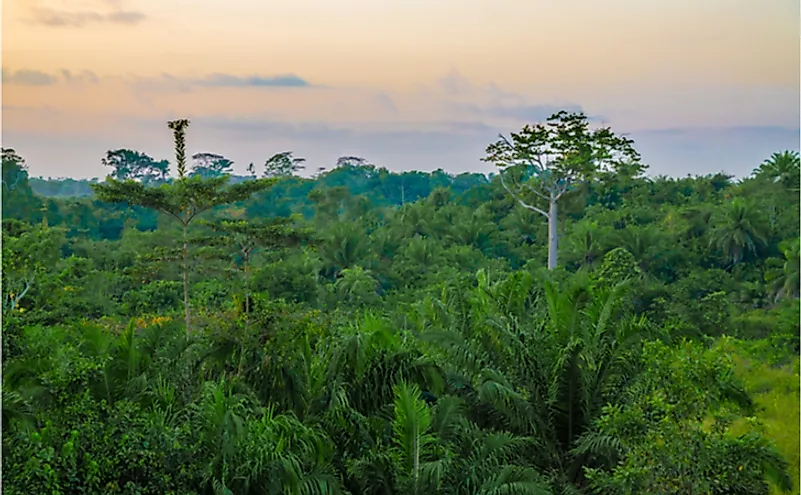What Are The Major Natural Resources Of Liberia?

Liberia is a sub-Saharan country located on the West African coast. It covers a total area of approximately 43,000 square miles and has a population of about 4.7 million people. Liberia is bordered to the northwest by Sierra Leon, to the north by Guinea, and the east by Ivory Coast. It has a coastline along the Atlantic Ocean. Liberia was the first African republic to declare independence (1847) and is the first and the oldest modern republic in Africa. The country managed to retain its independence during the Scramble for Africa. Liberia underwent decades of political and civil war, claiming the lives of thousands of civilians and displacing over one million people into refugee camps in neighboring countries. The instability affected the country’s economic growth and exploitation of natural resources.
Natural Resources Of Liberia
Liberia is one of the poorest countries in Africa and has an extremely underdeveloped economy, largely due to the First Liberian Civil War (1989-1996). The civil war destroyed the economy, and cause loss of infrastructure and capital, as well as brain drain. The death and displacement of people further slowed down economic development. Liberia is richly endowed with mineral resources such as diamond, iron ore, and gold. The country also has abundant water resources, forests, and a climate that favors agriculture. However, poor human capital and infrastructure have slowed down their exploitation. The majority of the population is dependent on subsistence farming. Here are the country’s major natural resources.
Diamond
Liberia has rich mineral resources and mineral extraction has historically been one of the most lucrative activities in the country. One of the most important minerals of Liberia is diamond. In Liberia, diamond is produced from both primary kimberlite sources and secondary alluvial placers. There are more than 160 known occurrences of kimberlite in many parts of the country. The Man Shield underlying the large parts of central and western Liberia host numerous kimberlite dikes, some of which are known to be diamondiferous. However, the kimberlites are yet to be fully exploited for diamond and the number of economic potential ones are yet to be known. The recent increase in diamond production in Liberia is attributed to the increase in the number of alluvial diamond deposits under exploration and the increased mechanization of the production process. The Lofa River region hosts significant alluvial diamond production. Other areas with large deposits of alluvial diamond include Du River, Sinoe River, and Kumgbor River. Diamond production in these areas has used primitive techniques and while prospective areas have not been evaluated using modern methods.
Gold
Liberia has a long history of artisanal gold mining, peaking at over 30,000 ounces per annum in the 1940s. Between 2008 and 2012, gold production averaged 20,000 ounces per annum. Liberia has two types of gold deposits; greenstone and alluvial placer deposit. There are approximately 600 gold occurrences in the country, with gold placer accounting for approximately 80% of the total. The deep and intense weathering coupled with clay and gravel deposits has favored the development of gold placers across the country. Most of the deposits are worked by artisanal miners. Several gold belts in Liberia have been defined based on the distribution of alluvial placer deposits. These gold belts include Bea Mountain, Masawo-Zolowo-Zorzor, Bukon Jedeh, Cestos River, Putu Range-Zwedru, and Saint John’s River-Kokoya. The wide distribution of placer gold deposits in Liberia indicates the potential for more gold discoveries. The underexplored areas are the priority targets for future exploration.
Iron Ore
West Africa accounts for 15% of the iron ore production in Africa, with most mines located in Liberia, Sierra Leon, and Guinea. Liberia was the leading iron ore producer in Africa and 7th in the world in the 1970s. During this period, it became the 3rd largest iron ore exporter in the world. The country has numerous iron ore occurrences and deposits with the most being the banded iron formation (BIF) type. Of the eight major iron ore deposits in Liberia, six are located within the Liberian Age Archean basement in western and central Liberia. The other two major deposits are located in the Uburnean terrane and Pan African coastal belt. Most of the iron ore mines including Nimba and Yekepa were closed in 1992 when the intensity of the civil war increased. After the cessation of the war production again began and was undertaken by Bong Mines Company Limited. Currently, iron ore is mined at two mines, Mount Tokadeh which produced about 5 million tons in 2014, and Bong Mine which produced 500,000 tons in the same year. In 2013, Liberia was the 23rd largest iron ore producer after just three years of production.
Forestry
According to the Food and Agricultural Organization, about 50% or 4.3 million hectares of Liberia is forested. This is a larger proportion compared to most of the African countries. Of the total forest cover, 175,000 hectares or 4% is classified as primary forest and about 8,000 hectares is planted forest. The large forest cover is attributed to the favorable climate that supports the growth of a variety of plants. During the civil conflict, the country lost about 0.6% of the forest cover every year. The forests are major sources of timber and rubber which have been Liberia’s main export products since the end of the war. Liberia earns over US$ 100 million annually from timber export and an additional $ 70 million from rubber. However, the growing number of illegal lumbering is threatening the existing forest cover. The government of Liberia, with the help of other organizations, has come up with the new National Forestry Policy to regulate and supervise the forest sector.











